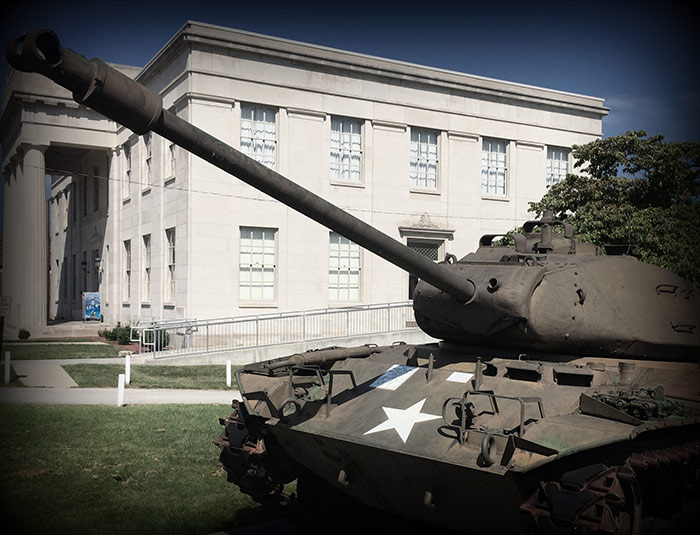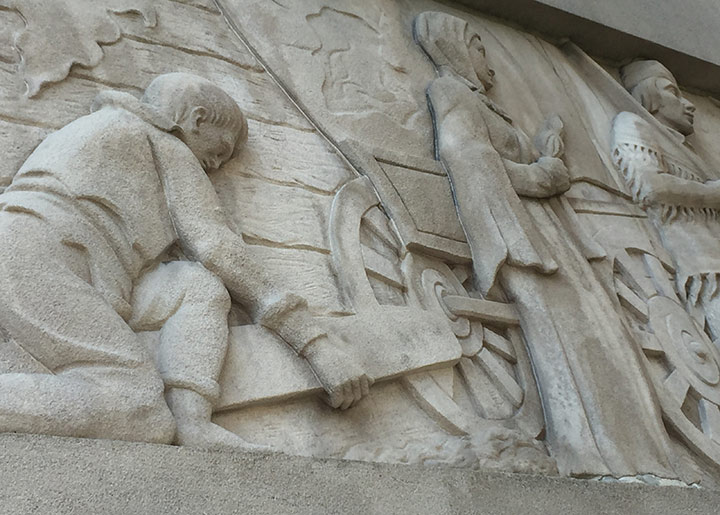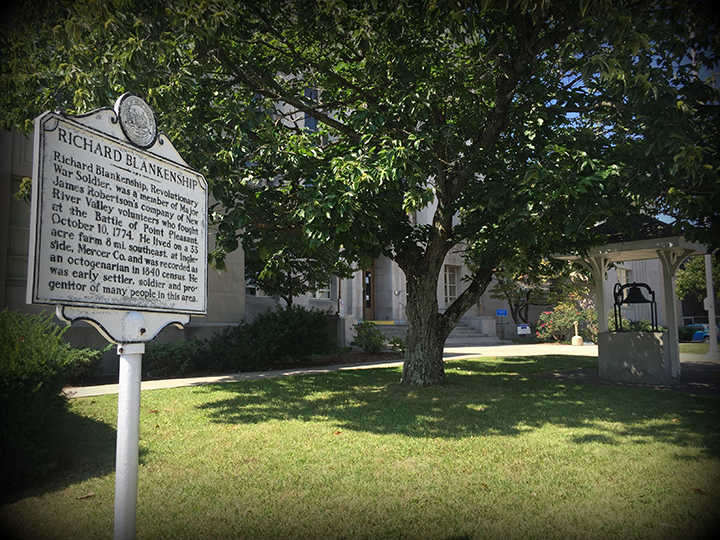Mercer County is among the most diverse and complex of West Virginia’s 55 counties. Its 420.8 square miles range from the rolling farmland of the New River Valley on the east, to the craggy promontory of Pinnacle Rock State Park to the west, and the coalfields beyond. Mercer County’s history is as varied as its geography.
Drained by the New, Bluestone, and East rivers, Mercer County has the highest mean elevation of any of the state’s counties. Its most prominent topographic features are the towering edifice of East River Mountain to the south and the Bluestone Gorge to the northeast. Mercer lies on the Virginia state line, surrounded by Summers, Raleigh, Wyoming, and McDowell counties in West Virginia, and the Virginia counties of Giles, Bland, and Tazewell. Substantial evidence attests to the prehistoric habitation of the region, including palisaded Mississippian culture corn-farming villages at Crump’s Bottom and Clover Bottom.
White settlers migrated into the region before 1800, and established settlements at Beaver Pond, Lake Shawnee, Oakvale, and Flat Top. There was no resident native population at the time of white settlement, but the region participated in the bloody conflict with Indian raiders that characterized the late 18th century. Additional settlers, including Primitive Baptist dissenters at Camp Creek, brought the population to 2,000 by 1837. Mercer County was created on March 17, 1837, from parts of Giles and Tazewell counties. The county was named for Revolutionary War Gen. Hugh Mercer. Princeton, the new county seat, was named for the 1777 Battle of Princeton, New Jersey, at which General Mercer fell. Most of the people were farmers, growing corn, oats, and wheat, and in their isolation they created a self-sustaining local economy including a saltworks, tannery, gristmill, and foundry.
The sectional tensions that brought on the Civil War found Mercer County decidedly southern in its sentiments. There were several hundred slaves among the 6,000 inhabitants of 1860. Remoteness and rugged terrain kept Mercer County from playing a significant role in the conflict, yet incursions by both sides resulted in skirmishes in the New River Valley and especially at Princeton, where the May 1862 Battle of Pigeon Roost resulted in the burning of the county seat. Several companies of Confederate troops were recruited from the eastern portion of the county along the New River.
Reconstruction brought turmoil to Mercer County, as the state-making Republican Unionists created Summers County in 1871, stripping some 128 square miles from Mercer. Moreover, state authorities in Wheeling tried to move the county seat from secessionist Princeton to Athens, but West Virginia’s ‘‘redemption’’ by the Democrats in 1872 returned county government and the all-important land records to Princeton.
The most significant events in the county’s history occurred after the Civil War, as railroads and coal mining rapidly industrialized southern West Virginia. Large areas of Mercer County in its northwestern portion are underlain with massive deposits of the famed ‘‘smokeless’’ Pocahontas No. 3 coal seam, which became a target of aggressive northern capitalists. Mining began soon after the Norfolk & Western Railway arrived in 1883. The first mine opened on Mill Creek at Coopers in 1884, and soon coal operators from Pennsylvania began opening mines along the Bluestone River, at Buckeye, Duhring, Goodwill, and Freeman.
Coal mining was labor intensive, and the population of Mercer County grew dramatically, rising from 7,500 in 1880 to 16,000 in 1890, 23,000 in 1900, and 50,000 in 1920. The increasingly diverse population included large numbers of African-Americans and southern and eastern European immigrants. Large mining operations opened at McComas, Turkey Gap, and Coopers, and the ‘‘Millionaires’ Town’’ of Bramwell grew up suddenly. In 1942, Mercer County’s 3,500 miners produced 3,500,000 tons of coal. A huge DuPont plant produced gunpowder at Nemours.
Even more significantly, the N&W had chosen an open meadow at the headwaters of the Bluestone and East rivers for its Pocahontas Division headquarters. Naming the new community Bluefield for the azure chicory growing along neighboring Stony Ridge, the railroad attracted utilities, banks, and wholesale and retail warehouses to the new town. Soon Bluefield was the largest community in the county, and one of West Virginia’s major cities. Huge stone buildings such as the 12-story West Virginian Hotel symbolized both the power of the coal industry and the rapid transformation which had occurred.
As the new industrial city grew, another courthouse struggle ensued in 1906. This time Democratic Princeton barely defeated Republican Bluefield in the battle for the county seat. When the rival Virginian Railroad chose Princeton for its regional headquarters, the county seat, too, began to share the growth produced by the coal industry.
Mercer County’s population continued to grow robustly until 1950, when its 75,000 residents began to feel the effects of mechanization of the mining industry. Thereafter the number of Mercer Countians declined, to an estimated an estimated 62,523 in 2012. Transportation connections wrought yet another series of changes, as the intersection of four-lane U.S. 460 and Interstate 77 near Princeton again reshaped county population and settlement patterns. The 1974 completion of East River Mountain Tunnel on I-77 eliminated a long-standing barrier to north-south traffic across the state line. The railroads, now all part of Norfolk Southern Corporation, remain important in the Mercer County economy.
No Mercer Countian has served as West Virginia governor, although Bluefield’s powerful Democratic Kee family held the Fifth District seat in the U.S. House of Representatives from 1932 to 1972. Elizabeth Kee became the Mountain State’s first woman in Congress. Prominent Mercer Countians include Bluefield’s Hugh Ike Shott, politician and editor of the influential Bluefield Daily Telegraph. Howard B. Lee served as attorney general of the state from 1925 to 1933. Bluefield was home to the feared Baldwin-Felts Detective Agency, pioneer radio station WHIS, and Nobel Prize winner John Forbes Nash. W. M. Ritter’s timber operation began at Oakvale. Mercer County is home to Bluefield State College and Concord University, both institutions of the West Virginia higher education system. Hank Williams was last seen alive in Bluefield, and Cal Ripken Jr. played minor league baseball for the Bluefield Orioles. Mercer County has 18 sites listed on the National Register of Historic Places.
This Article was written by C. Stuart McGehee
Last Revised on June 03, 2013
McGehee, C. Stuart “Mercer County.” e-WV: The West Virginia Encyclopedia. 03 June 2013. Web. 29 August 2016.



